
KANGAROOS
SUPER COHORT MARSUPIALIA
COHORT AUSTRALIDELPHIA
ORDER DIPROTODONTIA
FAMILY MACROPODIDAE
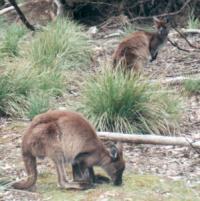 |
Kangaroo Island Kangaroos grazing in Flinders Chase National Park, Kangaroo Island, South Australia. The animals shelter in the bush during the day and come out to graze as dusk approaches. This kangaroo is a subspecies of the Western Gray Kangaroo but is smaller, darker and has longer fur than the mainland species. |
| As well as such well known animals
as kangaroos and wallabies,
the family Macropodidae includes less familar marsupials, such as
tree kangaroos, pademelons, quokkas,
bettongs and potoroos.
Ancestral macropods were forest dwelling browsers. Modern macropods are
adapted to a range
of habitats; woodlands, forests, rocky outcrops, cliffs and plains.
The desert-adapted, grass-eating kangaroos arose some 5 -1 5 years mya.
Traditionally large and small species were called wallabies
and kangaroos respectively, nowadays the name 'kangaroo' covers them both.
Ecologically macropods fill the niche of antelopes, deers and horses, having evolved lightened, long limbs with reduced toes that enable them to cover long distances over open ground at speed to evade predators. |
Typically macropods have:
| 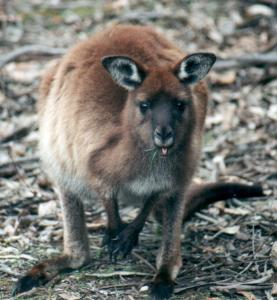 Kangaroo Island Kangaroo, a subspecies of the Western Gray Kangaroo (Macropus fuliginosus) |
| Most members of the family travel by hopping, taking off on their hind feet, landing on their fore limbs and tail, pushing off again with their hind limbs. The elongated and very strong fourth toe of the hind foot serves as a lever to propel the animal along and bears the animal's weight when it stands. Long legs increase the stride when hopping. Forelimbs and tails prop them up when they crawl slowly to feed. Powerful hind limbs and large heavy tail serve for balance and support. Tree kangaroos have shorter prehensile tails and climb rather than hop. | 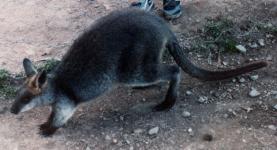 |
|
Our skeleton of a red kangaroo shows the distinctive features
which enable macropods to hop and crawl along:
The epipubic bones can be seen protuding from the front of the pelvis: a feature of monotremes and marsupials, their function is not known!. |
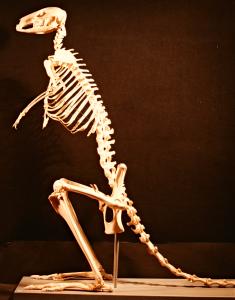 Red kangaroo skeleton ( Macropus rufus) |
Many kangaroo species are grazers and browsers adapted to living in dry desert habitats. Their muzzles, teeth and tongues are adapted to taking small food items. Their digestive physiology and a large stomach, with several chambers for fermentation, can process poor quality food.
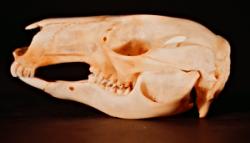 | Kangaroo skull: The basic dental formula of adult animals is I3/1; C0/0; PM variable; M4/4 |
Kangaroos'skulls and dentition show special adaptations to feeding on an abrasive diet of grass.
- an arc of blade-like upper incisors surrounds a fleshy pad at the front of the palate;
- the two procumbent lower incisors hold leaves against the pad;
- the leaves are stripped off against the edge of the arc of the upper incisors;
- canines are absent and the diastema between the incisors stores food before it is passsed to the molars;
- cheek teeth are:
- reduced in number;
- have transverse ridges to process hard grasses
- the unspecialised premolars and molars of large kangaroos erupt sequentially at the back of the mouth and are shed as they wear out, like elephants' teeth.
- other macropods have persistent premolars and four erupted molars which wear out simultaneously.
Most species of macropods are relatively abundant. Some, such as several tree kangaroos, are threatened, but others, like the grey and red kangaroos, have flourished and are now considered to be pests.
| Endangered species | Pest species |
| Bandicoots | Dasyurids | Marsupial moles |
| Thylacine | Koalas | Wombats |
| Possums | Feathertail or pygmy glider |






